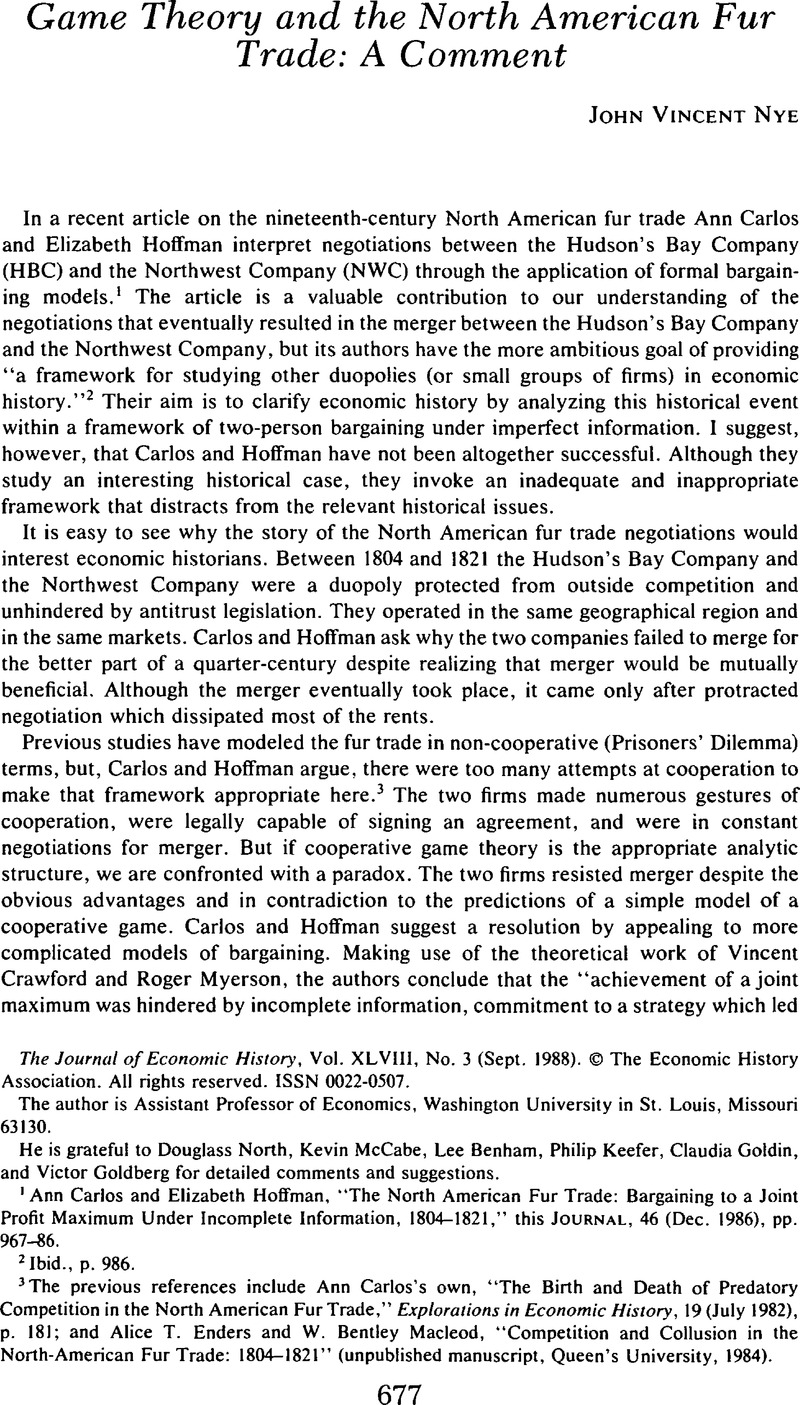Article contents
Game Theory and the North American Fur Trade: A Comment
Published online by Cambridge University Press: 03 March 2009
Abstract

- Type
- Notes and Discussion
- Information
- Copyright
- Copyright © The Economic History Association 1988
References
The author is Assistant Professor of Economics, Washington University in St. Louis, Missouri 63130.
He is grateful to Douglass North, Kevin McCabe, Lee Benham, Philip Keefer, Claudia Goldin, and Victor Goldberg for detailed comments and suggestions.
1 Carlos, Ann and Hoffman, Elizabeth, “The North American Fur Trade: Bargaining to a Joint Profit Maximum Under Incomplete Information, 1804–1821,” this JOURNAL, 46 (12 1986), pp. 967–86.Google Scholar
2 Ibid., p. 986.
3 The previous references include Carlos, Ann's own, “The Birth and Death of Predatory Competition in the North American Fur Trade,” Explorations in Economic History, 19 (07 1982), p. 181;CrossRefGoogle Scholar and Enders, Alice T. and Macleod, W. Bentley, “Competition and Collusion in the North-American Fur Trade: 1804–1821” (unpublished manuscript, Queen's University, 1984).Google Scholar
4 Carlos, and Hoffman, , “The North American Fur Trade”, abstract, p. 967.Google Scholar The original bargaining models are discussed in Myerson, Roger B., “Two-person Bargaining Problems with Incomplete Information,” Econometrica, 52 (03 1984), pp. 461–87;CrossRefGoogle Scholar and “Cooperative Games with Incomplete Information,” International Journal of Game Theory, 13 (1984), pp. 69–96;Google ScholarCrawford, Vincent P., “A Theory of Disagreement in Bargaining,” Economegrica, 50 (05 1982), pp. 607–38.CrossRefGoogle Scholar
5 Carlos, and Hoffman, , “The North American Fur Trade,” p.969.Google Scholar
6 Ibid., p. 969.
7 Crawford's model is designed to show why pre-commitment is possible given the ex-post risks of such a stance. Nonetheless, it cannot be made to accommodate a situation in which commitment should not adjust to changing circumstance. The bargaining stance should at least be ex-ante rational though not necessarily ex post. (“A Theory of Disagreement in Bargaining”, pp. 612–13.)
8 This criticism is truer of Myerson than Crawford, who does consider some of the implications of repeated play.
9 Myerson, , “Two-person Bargaining Problems with Incomplete Information,” p.478, gives an example of union-management negotiations in which management must accept a stance that permits the possibility of a prolonged strike to prove that it cannot afford to pay high wages. However, workers would not be able to sustain a strike because they would realize after it had begun that management was telling the truth about its inability to pay high wages. In much the same way, the breakdowns in negotiation should have signaled to the two fur traders that their demands were unreasonable and caused them to revise their positions.Google Scholar
10 “The fundamental distinction between cooperative and noncooperative games is that cooperative games allow binding agreements [emphasis added\ while noncooperative games do not,” Friedman, James W., Game Theory with Applications to Economics (New York, 1986) p. 148.Google Scholar
11 Carlos, and Hoffman, , “The North American Fur Trade,” p. 971.Google Scholar
12 Ibid., p. 973.
13 Ibid., p. 984.
14 Ann Carlos, “The Birth and Death of Predatory Competition in the North American Fur Trade”; and Enders and Macleod, “Competition and Collusion in the North-American Fur Trade:1804–1821”.
15 The classic work on how cooperation may emerge from non-cooperation remains Axelrod, Robert's The Evolution of Cooperation (New York, 1984).Google Scholar
16 Crawford, in “A Theory of Disagreement,” pp. 623–24, contains a discussion of the limitations of the literature on bargaining. Especially troubling is the reliance on “full-game theoretic rationality”, the use of Bayesian Nash equilibria as the only acceptable rational solutions, the restrictions on players' expectations, and the assumption that all players have common knowledge about the game's structure. By relaxing the assumptions of the model, he creates a bargaining game that reduces to a repeated Prisoners' Dilemma. From the standpoint of deriving new and improved theory, such a result is not heartening.Google Scholar
- 2
- Cited by


